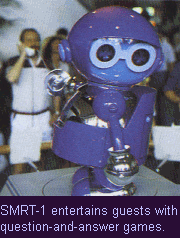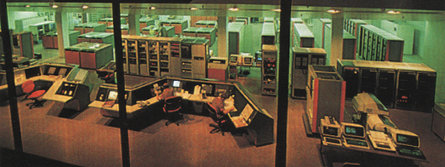 |
Home > Pavilion > Ride/Show Technology > EPCOT Computer Central

 The area of Innoventions that now houses Guest Relations, was once the technological heart of EPCOT Center.
Tucked away in the far corner of what was then Communicore East, was EPCOT Computer Central, known to Cast
Members simply as "Central". The guest areas featured a lobby filled with interactive displays and games,
from the squeaky-voiced "SMRT-1", a robot that played question-and-answer games using the then-exotic
technology of voice recognition, to a touch screen where you could build and "ride" your own virtual roller coaster.
The real treat here though was "Backstage Magic" (an updated, and slightly more sophisticated show which
replaced the kitschy "Astuter Computer Review"). Here guests experienced a first for a Disney theme park
(and quite probably for any theme park). They got to witness first-hand some of the machinery that helps
"make the magic."
The area of Innoventions that now houses Guest Relations, was once the technological heart of EPCOT Center.
Tucked away in the far corner of what was then Communicore East, was EPCOT Computer Central, known to Cast
Members simply as "Central". The guest areas featured a lobby filled with interactive displays and games,
from the squeaky-voiced "SMRT-1", a robot that played question-and-answer games using the then-exotic
technology of voice recognition, to a touch screen where you could build and "ride" your own virtual roller coaster.
The real treat here though was "Backstage Magic" (an updated, and slightly more sophisticated show which
replaced the kitschy "Astuter Computer Review"). Here guests experienced a first for a Disney theme park
(and quite probably for any theme park). They got to witness first-hand some of the machinery that helps
"make the magic."
After ascending a steep ramp and watching a short preshow on overhead monitors, guests were allowed into
the "theater"--which was actually two narrow balconies, overlooking the glass-walled computer room below.
Long, sleek consoles faced the glass wall, while a myriad of equipment cabinets in different configurations
extended back well past the guests' view. While Central operations Cast Members went about their business
in full view, a multimedia show was presented for the guests. Effects were projected on the glass wall
(using the "Pepper's Ghost" effect, which many will remember from the Haunted Mansion's ballroom
scene). Additional show elements, including a scale model of EPCOT, projection screens, and other special
effects were presented above the glassed-in area, at roughly eye-level with the guests.


The show's hostess was Julie, a pint-sized apparition who seemingly walked across the tops of consoles,
produced a "bridge" across the consoles out of glittering light, and introduced the real stars of the show,
"MACS" (pronounced "MAX") and "ECS" (pronounced "X"). "MACS", or Monitoring and Control System, handled ride
operations while "ECS" or Entertainment Control System managed the park's entertainment.

All Roads Lead to Central
The multimedia presentation showed graphically how every part of the park, from nearby Univerese of Energy,
to the far reaches of World Showcase were tethered to their technological mastermind in Central. It was here
that all the audio, show control, lighting control, environmental control--indeed nearly everything involved
in running the park--originated. Central was linked to these far-flung locations through a park-wide network
of fiberoptic cables. Fiberoptics supplied not only control information, but even video for World Key
Information System and other interactive displays.
"MACS" and "ECS" were not single computers as the show may have implied (for simplicity sake), but were
rather collections of machines working in unison to put on one of the most technologically complex shows of
its time. "MACS" consisted of, among other things, "Bin Loops"--giant 24-track continuous-loop audio tape
machines which supplied both the major audio tracks for the attractions, and also the timing signals for
Audio-Animatronics and show elements. (Shorter audio segments were on continuous-loop cartridge tapes).
Also part of MACS were the "SCUs" or "Show Control Units", which were responsible for controlling the show
elements (Audio-Animatronics, films, special effects, etc) in the attractions. Nearly everything guests
experienced, from the roar of a dinosaur in Universe of Energy, to Mark Twain climbing a flight of stairs
in the American Adventure, was orchestrated by MACS.
ECS consisted of four DEC MicroVAX's, named Huey, Dewey, Louie and Donald. They managed show lighting and
other effects for the park's entertainment, including outdoor shows. Light poles sprung from "solid" rock,
park lighting dimmed in preparation for Illuminations, a rousing musical score sprang from unseen speakers--all
at the direction of ECS.
Toward the back of Central--well outside of view of guests in Backstage Magic's theater--was a an entire wall
covered with rows and rows of Pioneer Laserdisc players. They supplied the video for the World Key Information
System and Communicore's interactive displays, including Energy Exchange's interactive Energy Access terminals.
In front of the wall of Laserdisc players, were four refrigerator-sized DEC VAX11/780's, three of which were
used for running World Key.

EPCOT Unplugged
The details are skill sketchy to us at this time, but as we understand it, Central has either been eliminated
or significantly scaled-back. It seems that much of Central's functionality has been localized at each
attraction. This may offer some technical advantages, and should reduce the vulnerability that was inherent
in a centralized system. Though Central was heavily protected (with uninterruptible power supplies and redundant
systems), it did "crash" at least once, taking down the entire park at once! It's a surreal site, seeing a
park so dependent on technology, coming to a screeching halt.
Despite the potential benefits from decentralization of the park's systems, we can't help but be a little
nostalgic for the old days, where were could witness the "backstage magic", all being orchestrated from one
place, right before our eyes.

Last Chance to See
Though Central as we know may be gone, you can still get a glimpse of it. How? Check out the 1980's Disney
movie D.A.R.R.Y.L.. The "computer lab" scenes featured in the film were actually shot in Central,
with SCUs and other equipment bearing temporary placards to pose as "D.A.R.R.Y.L.'s" computers.

|
 |
|
|





